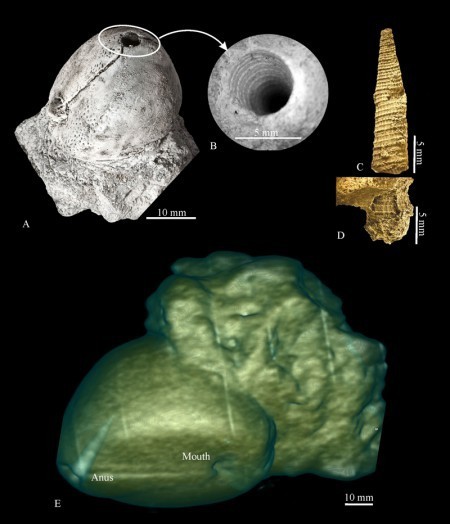Marc Abrahams's Blog, page 334
April 19, 2015
Ig Nobel update: How well do oil and water mix, five years later?
David Biello writes, in Scientific American, about “The Enduring Mystery of the Missing Oil Spilt in the Gulf of Mexico” — a detective story whose beginnings were told in an Ig Nobel Prize-winning study:
Workers uncovered a tar mat weighing some 18,000 kilograms just offshore of a natural barrier island in Louisiana in the summer of 2013. Although the tar mat turned out to bear more sand than oil, it represented another small fraction of the hydrocarbons that went missing after BP’s blowout in the Gulf of Mexico in 2010. The sum of all the dispersed oil located thus far, from tar mats to oily marine snow, hardly accounts for at least four million barrels of oil spewed into the cold, dark bottom of the Gulf of Mexico from the deep-sea well named Macondo five years ago. Like any good mystery, this one may never be solved….
 The 2010 Ig Nobel Prize for chemistry was awarded to Eric Adams [pictured here] of MIT, Scott Socolofsky of Texas A&M University, Stephen Masutani of the University of Hawaii, and BP [British Petroleum], for disproving the old belief that oil and water don’t mix. [REFERENCE: “Review of Deep Oil Spill Modeling Activity Supported by the Deep Spill JIP and Offshore Operator’s Committee. Final Report,” Eric Adams and Scott Socolofsky, 2005.]
The 2010 Ig Nobel Prize for chemistry was awarded to Eric Adams [pictured here] of MIT, Scott Socolofsky of Texas A&M University, Stephen Masutani of the University of Hawaii, and BP [British Petroleum], for disproving the old belief that oil and water don’t mix. [REFERENCE: “Review of Deep Oil Spill Modeling Activity Supported by the Deep Spill JIP and Offshore Operator’s Committee. Final Report,” Eric Adams and Scott Socolofsky, 2005.]

April 18, 2015
Randomness As a Tool to Produce More Women Leaders
Further fodder for using randomness to make choices that are traditionally made by other, judgment-based methods:
 “Women have to enter the leadership race to win: Using random selection to increase the supply of women into senior positions,” Amanda H. Goodall [pictured here] and Margit Osterloh, 2015. The authors, at Cass Business School, City University, London and the University of Zürich, explicitly build on the work of 2010 Ig Nobel management prize winners Alessandro Pluchino, Andrea Rapisarda, and Cesare Garofalo:
“Women have to enter the leadership race to win: Using random selection to increase the supply of women into senior positions,” Amanda H. Goodall [pictured here] and Margit Osterloh, 2015. The authors, at Cass Business School, City University, London and the University of Zürich, explicitly build on the work of 2010 Ig Nobel management prize winners Alessandro Pluchino, Andrea Rapisarda, and Cesare Garofalo:
“The supply of women into senior management has changed little despite well intentioned efforts. We argue that the biggest effect is from supply-side factors that inhibit females’ decision to enter competitions: Women are under-confident about winning, men are over-confident; women are more risk averse than men in some settings; and, most importantly, women shy away from competition. In order to change the conditions under which this is the case, this paper proposes a radical idea. It is to use a particular form of random selection of candidates to increase the supply of women into management positions. We argue that selective randomness would encourage women to enter tournaments; offer women ‘rejection insurance’; ensure equality over time; raise the standard of candidates; reduce homophily to improve diversity of people and ideas; and lessen ‘the chosen one’ factor. We also demonstrate, using Jensen’s inequality from applied mathematics, that random selection can improve organizational efficiency….
“Random processing, which includes screening to filter out inappropriate candidates, can in principle be used in many settings to correct and improve different kinds of procedures.18 Zeitoun, Osterloh and Frey (2014) propose developing a corporate governance model using random selection procedures to appoint stakeholder representatives to corporate boards. Pluchino, Rapisarda and Garofalo (2011) suggest using partial random selection as a promotion strategy that protects again the Peter Principle.”

Nature (presecription strength)
Nature is now available in Prescription Strength, which is up for an award:
(Thanks to Margaret Atwood for bringing this to our attention.)

A partial history of parliamentary fistfighting
The NewsLens news site gives a pictorial partial history of fistfights in parliaments in various countries, with a knowing nod to the 1995 Ig Nobel Peace Prize, which was awarded to the Taiwan National Parliament, for demonstrating that politicians gain more by punching, kicking and gouging each other than by waging war against other nations.

April 17, 2015
Sonifications in the control room
Those whose work involves monitoring highly complex industrial procedues sometimes have difficulty attending to several concurrent processes (at the same time). To this end :
“
Computer scientists at the Cluster of Excellence Cognitive Interactive Technology (CITEC) at Bielefeld University and the University of Vienna have developed a method that allows control room staff to monitor several processes at the same time”
Their answer, in a word, is ‘sonification’. The scientists, whose paper ‘A Sonification System for Process Monitoring as Secondary Task’ is published in Proceedings of the 5th IEEE Conference on Cognitive Infocommunication,
provide a sonificated example of what it might be like to work in such a control room. [mp4 format] Further research is required though say the investigators :
“First pre-tests suggest that with the developed system, users are indeed able to infer states and the need to intervene, however, whether it improves performance over visual-only and simple auditory-warning based systems in a significant manner still has to be proven.”

April 16, 2015
What is your favorite dinosaur, and why?
Darrin Pagnac, of the Museum of Geology at the South Dakota School of Mines and Technology, teache sthe course GEOL 372, Dinosaurs, every spring. He writes (in the Transforming Time Into Space blog):
The course is geared toward sophomore majors and upper-level non-majors. I specifically keep it light and utilize it less to instruct the intricacies of paleontology and more as a tool to instill skepticism and critical thinking skills. It’s a very popular course and, most likely because of the content, I generally get very good teaching reviews. After the systematics portion of the course where I outline the various types of dinosaurs, the exam includes the question, “What is your favorite dinosaur and why?” I’ve been tabulating the answers for five years and the results are intriguing.
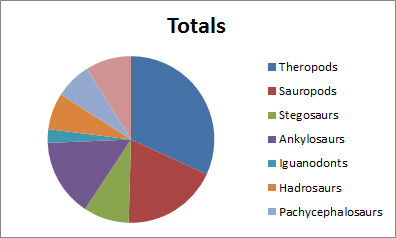
Above is a pie chart of the total percentage of answers to this question. I find it interesting that there is a 50/50 split between Saurischia (theropods and sauropods) and Ornithischia (all other groups). In terms of totals, theropods are the clear leader for obvious reasons; they have sharp teeth, claws, are fast, agile, and awe inspiring. I do take note of subdivisions of theropods as well, and, as expected, “raptors” are generally the front-runner with Tyrannosaurus a close second.
The next most common favorite is sauropods, but for completely different reasons. Students who like sauropods are drawn to their ubiquitous nature. Sauropods seem to be the “go-to”, iconic dinosaur and are found everywhere from old cartoons, to gas station signs, to displays in major airport terminals, to cheesy tourist traps. Sauropods have been these students’ favorites since childhood
Ornithischians are a more mixed lot. Because ornithischians contain six groupings as opposed to saurischia’s two, simple statistics dictate that responses to these groups will be more dilute, and this is indeed the case. Below is a bar chart illustrating the breakdown of favorite dinosaur group by year, as well as the totals. As you can see, it varies a great deal by year which ornithischian group comes out on top.
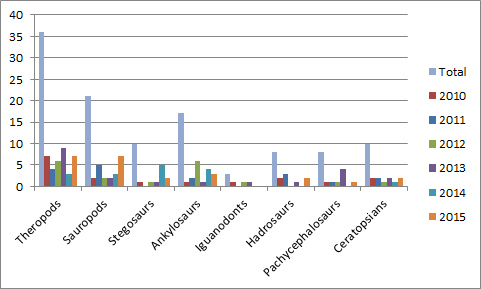
Ankylosaurs are the leader for favorite ornithischian group due to their distinctive appearance and “weaponry”. The same attraction draws students to ceratopsians and stegosaurs; horns and spikes apparently appeal to repressed blood-lust. Pachycephalosaurs appeal for similar reasons. Despite the fact that my pachycephalosaur lecture is devoted to debunking the head-butting myth, students still seem to relish the idea of dinosaurs running full-tilt into each other’s thickened crania. Finally, the students who are drawn to hadrosaurs generally hearken back to a favorite childhood movie or cartoon. Iguanodonts get no love, which is too bad. How can you hate a dinosaur that’s constantly giving you the “thumbs-up”?
I constantly refer to paleontology as the “gateway drug to science”. Paleontology is a fantastic tool for STEM education and for fostering curiosity and passion for science. Dinosaurs work gloriously in this capacity as they provide an approachable way to illustrate scientific concepts and critical thinking applications. After I’ve destroyed childhood viewpoints with my pachycephalosaur lecture, I often find many students openly angry at the idea that no head-butting likely occurred. When I ask them why they are so angry, they generally state in some way that they’ve become emotionally attached to this imagery or idea. I then tell them to think about this next time they hear a debate about climate change, or creationism, or anti-vaccination, or GMOs, or any politically heated argument. It’s difficult to change your mind about something you’re emotionally invested in. I encourage them to keep an open mind.
Sixty-five million years later, dinosaurs can still have a lasting and positive effect on the world…

April 15, 2015
Podcast #7: Trinkaus, a further look (at things that annoy him)
Continuing what we started last week (in Podcast #6) the happily annoyed works of Professor John Trinkaus — who counts things that annoy him — bubble further forth in this week’s Improbable Research podcast.
LISTEN on Play.it or iTunes (or DOWNLOAD it, and listen later).
SUBSCRIBE on Play.it or iTunes, to get a new episode every week, free.
This week, Marc Abrahams tells about:
A further look at John Trinkaus and his approx 100 studies about things that annoy him. (Professor John Trinkaus / Citations of most of Trinkaus’s articles are in the article “Trinkaus: An Informal Look“, vol. 9, no. 3, [the special Everything issue] of the Annals of Improbable Research. / Ig Nobel Prizes awarded in 2003)
Exiting: Another Look. (“Exiting: Another Look,” J. Trinkaus, Perceptual and Motor Skills, vol. 71, no. 3, part 2, December 1990, p. 1317-8. / The dramatic reading is performed by Richard Baguley, technology writer)
Defining the Supermarket ‘Item': An Informal Look. (“Defining the Supermarket ‘Item': An Informal Look,” J. Trinkaus, Perceptual and Motor Skills, vol. 71, August 1990, p. 350. / The dramatic reading is performed by Jean Berko Gleason, professor emerita of psychology at Boston University, and inventor of the Wug Test)
Stop Sign Compliance: A Final Look. (“Stop Sign Compliance: A Final Look,” J. Trinkaus, Perceptual and Motor Skills, vol. 85, no 1, August 1997, p. 217. / The dramatic reading is performed by Richard Baguley)
An Informal Look at Use of Bakery Department Tongs and Tissues. (“An Informal Look at Use of Bakery Department Tongs and Tissues,” J. Trinkaus, Perceptual and Motor Skills, vol. 87, no. 3, part 1, December 1998, p. 801-2. / The dramatic reading is performed by Jean Berko Gleason)
Visiting Santa: An Informal Look. (“Visiting Santa: An Informal Look “, John Trinkaus, Psychological reports 95.2 (2004): 587-588. / The dramatic reading is performed by Richard Baguley)
Some of our favorite Trinkaus studies. (The dramatic reading is performed by Ross MacFarlane of the Wellcome Trust Library and James Harkin and Stevyn Colgan of QI, The Museum of Curiosity, and No Such Thing As a Fish, and Marc)
A Grand Old Plan for Vacuum Travel. (N. A. (1825). ‘London and Edinburgh Vacuum Tunnel Company, Capital 90,000 Sterling.’ Mechanics Register 1 (13): 205–7.)
The mini-opera “The Blonsky Device”, act 3 (of 4). (The opera premiered as part of the 2013 Ig Nobel Prize ceremony. Henry Akona orchestrated and directed. The opera starred Maria Ferrante (as Charlotte Blonsky), Martin Kelly (as George Blonsky), Philip Lima (as the zookeeper), and Miles Rind (as the patent examiner), with an orchestra of biomedical researchers directed by Dr. Thomas Michel. Karen Hopkin narrates. The opera also featured, in non-singing roles: Melissa Franklin, Peaco Todd, Alex Nemiroski, and Nobel laureates Roy Glauber, Dudley Herschbach, Frank Wilczek, and Eric Maskin.)
The mysterious John Schedler did the sound engineering this week.
The podcast is all about research that makes people LAUGH, then THINK — research about anything and everything, from everywhere —research that’s good or bad, important or trivial, valuable or worthless. CBS distributes it, both on the new CBS Play.it web site, and on iTunes.

Critical Studies in Men’s Underwear
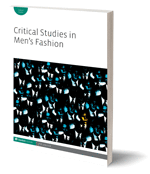 Issue number 2, volume 1, of the journal Critical Studies in Men’s Fashion, might be loosely described as “The Underpants Issue”. See for example the paper ‘What lies beneath? Thoughts on men’s underpants’ by Dr Prudence Black, BA SACAE Hons Macquarie MA UTS PhD Sydney, ARC DECRA Fellow, and colleagues.
Issue number 2, volume 1, of the journal Critical Studies in Men’s Fashion, might be loosely described as “The Underpants Issue”. See for example the paper ‘What lies beneath? Thoughts on men’s underpants’ by Dr Prudence Black, BA SACAE Hons Macquarie MA UTS PhD Sydney, ARC DECRA Fellow, and colleagues.
“This article consists of a number of thoughts about and meditations on men’s underpants. Beginning with a ‘day in the life’ of a standard pair of underpants, it moves on to explore some of the specific characteristics that accompany the wearing of this particular garment. There follows a consideration of the role played by underpants in the creation of male characters for screen and television. A brief look at Homer Simpson’s Y-fronts is followed by the examination of a crucial moment in the history of Australian undergarments, […]”
Or perhaps, instead, (or as well as) :’Revealing myself: A phenomenological approach to my underwear choices through the years‘ by Professor Jose Blanco F.
“In this article I apply a phenomenological approach to discuss my personal lived experience and creative authorship in selecting my underwear, thus, explaining the meanings created by my interaction with my underwear and how this clothing object has been shaped by my cultural context, socio-economic factors and my relation to my own body and sexuality. Underwear can be directly linked to questions of identity and a person’s location within a social context. Since identity can be read as imbedded in social relations and situations, it can be assumed that underwear is a dynamic tool in the construction of multiple identities. […]”
To peruse the journal’s entire table of contents go here.

April 14, 2015
Housework affects fertility (in Finland)
 Anneli Miettinen and colleagues at the Population Research Institute, Väestöliitto, Finland, have, perhaps for the first time, performed a study to examine whether housework might be linked in some way to (in)fertility. Results of their enquiries, published in the May 2015 issue of the journal Acta Sociologica :
Anneli Miettinen and colleagues at the Population Research Institute, Väestöliitto, Finland, have, perhaps for the first time, performed a study to examine whether housework might be linked in some way to (in)fertility. Results of their enquiries, published in the May 2015 issue of the journal Acta Sociologica :
“[…] show that women’s housework hours were negatively associated with the likelihood of having children at all parities. Men’s contribution to domestic tasks, measured in relative terms, had no impact on childbearing.”
See: ‘Women’s housework decreases fertility : Evidence from a longitudinal study among Finnish couples’

A rectal foreign body in a 65 million year-old Danish sea urchin
Since David B. Busch and James R. Starling, won the 1995 Ig Nobel Literature prize for their deeply penetrating 1986 research report, “Rectal foreign bodies: Case Reports and a Comprehensive Review of the World’s Literature” the body of literature on the subject and the number of cases has increased considerably. By 2012, no less than 589 reports on these inconveniences have been published. All cases, however, refer to humans. But now a paper has come to our attention that details the first documented case of a rectal foreign body in a 65 million year-old sea urchin from Denmark.
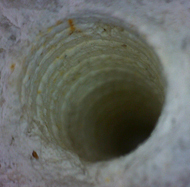 Jesper Milan, Bo W. Rasmussen and Lothar H. Vallon of Geomuseum Faxe and Natural History Museum of Denmark report ‘An unusual taphocoenosis of a sea urchin and a rectally inserted turriform gastropod from the lowermost Paleocene of Stevns Klint, Denmark’ in New Mexico Museum of Natural History and Science Bulletin 67 (2015): 231-234:
Jesper Milan, Bo W. Rasmussen and Lothar H. Vallon of Geomuseum Faxe and Natural History Museum of Denmark report ‘An unusual taphocoenosis of a sea urchin and a rectally inserted turriform gastropod from the lowermost Paleocene of Stevns Klint, Denmark’ in New Mexico Museum of Natural History and Science Bulletin 67 (2015): 231-234:
A specimen of the common irregular echinoid Echinocorys sulcata (Goldfuss, 1826), recovered from the lowermost Paleocene Stevns Klint Formation, at Stevns Klint, Denmark, is of note in revealing a perfect external mold of the turriform gastropod Cerithiella fenestrata (Ravn, 1902) in the anal opening. The gastropod penetrated over a length of 21 mm perpendicularly into the echinoid test, and impressions in the surrounding matrix show the gastropod to have protruded over a length of 8 mm out of the test, being tightly lodged in the periproctal opening. It is assumed that this unusual combination resulted from the activities of bioturbators which, by chance, pushed the empty gastropod shell into the anal opening of the test of the dead echinoid, although other, more colorful, explanations cannot be excluded.
When asked about the significance of this discovery, Jesper Milàn answered by e-mail:
… it might be of some comfort for the unfortunate people who had to take the long walk to the doctor, to know it has happened to sea urchins long before any humans were present on the planet.
The images below illustrate the remarkable fossil association, where A is the sea urchin, B close-up of the anal opening showing the imprint of the gastropod shell, C silicone cast of the imprint, and E transparent CT-image of the sea urchin showing the orientation of the shell.
BONUS: Jesper Milàn (co)authored two recent papers that detail the discovery of vertebrate coprolites (fossil droppings) near the Danish shell-in-sea-urchin and elsewhere in Europe.

Marc Abrahams's Blog
- Marc Abrahams's profile
- 14 followers


